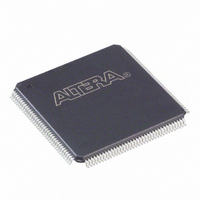EPF10K30ETC144-3 Altera, EPF10K30ETC144-3 Datasheet - Page 27

EPF10K30ETC144-3
Manufacturer Part Number
EPF10K30ETC144-3
Description
IC FLEX 10KE FPGA 30K 144-TQFP
Manufacturer
Altera
Series
FLEX-10KE®r
Datasheet
1.EPF10K30ETC144-3.pdf
(100 pages)
Specifications of EPF10K30ETC144-3
Number Of Logic Elements/cells
1728
Number Of Labs/clbs
216
Total Ram Bits
24576
Number Of I /o
102
Number Of Gates
119000
Voltage - Supply
2.375 V ~ 2.625 V
Mounting Type
Surface Mount
Operating Temperature
0°C ~ 85°C
Package / Case
144-TQFP, 144-VQFP
Lead Free Status / RoHS Status
Contains lead / RoHS non-compliant
Other names
544-1267
Available stocks
Company
Part Number
Manufacturer
Quantity
Price
Part Number:
EPF10K30ETC144-3
Manufacturer:
ALTERA/阿尔特拉
Quantity:
20 000
Company:
Part Number:
EPF10K30ETC144-3N
Manufacturer:
ALTERA
Quantity:
5 510
Company:
Part Number:
EPF10K30ETC144-3NQ
Manufacturer:
ALTERA
Quantity:
5 510
Company:
Part Number:
EPF10K30ETC144-3NQ
Manufacturer:
NS
Quantity:
5 510
FLEX 10KE Embedded Programmable Logic Devices Data Sheet
FastTrack Interconnect Routing Structure
In the FLEX 10KE architecture, connections between LEs, EABs, and
device I/O pins are provided by the FastTrack Interconnect routing
structure, which is a series of continuous horizontal and vertical routing
channels that traverses the device. This global routing structure provides
predictable performance, even in complex designs. In contrast, the
segmented routing in FPGAs requires switch matrices to connect a
variable number of routing paths, increasing the delays between logic
resources and reducing performance.
The FastTrack Interconnect routing structure consists of row and column
interconnect channels that span the entire device. Each row of LABs is
served by a dedicated row interconnect. The row interconnect can drive
I/O pins and feed other LABs in the row. The column interconnect routes
signals between rows and can drive I/O pins.
Row channels drive into the LAB or EAB local interconnect. The row
signal is buffered at every LAB or EAB to reduce the effect of fan-out on
delay. A row channel can be driven by an LE or by one of three column
channels. These four signals feed dual 4-to-1 multiplexers that connect to
two specific row channels. These multiplexers, which are connected to
each LE, allow column channels to drive row channels even when all eight
LEs in a LAB drive the row interconnect.
Each column of LABs or EABs is served by a dedicated column
interconnect. The column interconnect that serves the EABs has twice as
many channels as other column interconnects. The column interconnect
can then drive I/O pins or another row’s interconnect to route the signals
to other LABs or EABs in the device. A signal from the column
interconnect, which can be either the output of a LE or an input from an
I/O pin, must be routed to the row interconnect before it can enter a LAB
or EAB. Each row channel that is driven by an IOE or EAB can drive one
specific column channel.
Access to row and column channels can be switched between LEs in
adjacent pairs of LABs. For example, a LE in one LAB can drive the row
and column channels normally driven by a particular LE in the adjacent
LAB in the same row, and vice versa. This flexibility enables routing
resources to be used more efficiently (see
Figure
13).
Altera Corporation
27














